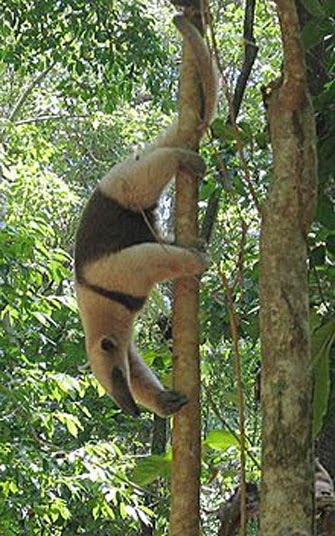
Wikipedia.org | Anteaters are the four mammal species of the suborder Vermilingua commonly known for eating ants and termites. Together with the sloths, they compose the order Pilosa. The name "anteater" is also colloquially applied to the unrelated aardvark, numbat, echidna, and pangolin.
Species include the Giant Anteater Myrmecophaga tridactyla, about 1.8 m (6 ft) long including the tail; the Silky Anteater Cyclopes didactylus, about 35 cm (14 in.) long; the Southern Tamandua or Collared Anteater Tamandua tetradactyla, about 1.2 m (4 ft) long; and the Northern Tamandua Tamandua mexicana of similar dimensions.
The largest extant representative of the group is the Giant Anteater, or ant-bear (Myrmecophaga tridactyla), an animal measuring up to 2.4 meter (8 feet) in length, excluding the tail, and up to 1.2 meter (4 foot) in height at the shoulder. It has a long, thin head and a large, bushy tail. Its prevailing color is gray, with a broad black band, bordered with white, starting on the chest, and passing obliquely over the shoulder, diminishing gradually in breadth as it approaches the loins, where it ends in a point. Giant Anteaters are sometimes mistaken for bears because of their claws and bushy fur. The Giant Anteater is also a very solitary animal. In Spanish, an anteater is referred to as an oso hormiguero, literally, "anteating bear."

Its food consists mainly of termites, which it obtains by opening nests with its powerful sharp anterior (front) claws. As the insects swarm to the damaged part of their dwelling, it draws them into its mouth by means of its long, flexible, rapidly moving tongue covered with sticky saliva. Their tongue can be flicked up to 150-160 times or more per minute. A full-grown giant Anteater eats upwards of 30,000 ants and termites a day. They also have small spikes on their tongue that help keep the ants and other insects on the tongue while they get swept into the anteater’s mouth.
The Giant Anteater and regular anteaters have no teeth. Their physical digestion is aided by the pebbles and debris that they consume when they are eating their protein-packed meal. Once the bugs are trapped by the sticky tongue, the bugs are crushed by the tongue, against the anteater's hard palate.
The giant Anteater lives above ground, not burrowing underground like armadillos or aardvarks. The anteater finds a place to sleep, curls up, and covers itself with its bushy tail. Since the anteater is a very solitary animal, it can be easily awoken. When attacked, it can defend itself with its sabre-like anterior claws.

The female produces one offspring per birth. During much of its first year of life, a young Anteater will ride on its mother's back. It is generally acknowledged that giant Anteaters have a poor sense of sight but a keen sense of smell. In fact, their sense of smell is regarded to be some 40 times stronger than that of humans. The name of the species, tridactyla, comes from "tri" and "dactylos", which is Greek for "three fingers". However, giant Anteaters actually have five toes on each paw (the fifth is vestigial). The name probably came about because only three of the front toes have prominent claws and can be easily seen. Giant Anteaters rarely make sounds. When they do it is mostly when they are young; the sound is a high-pitched, shrilly grunt noise. A baby that has fallen off his mother's back will grunt to its mother either to remind her that it has fallen off or to simply instruct her where it is or to get her attention.
The two Anteaters of the genus Tamandua, the Southern Tamandua (Tamandua tetradactyla) and the Northern Tamandua (Tamandua mexicana), are much smaller than the Giant Anteater, and differ essentially from it in their habits, being mainly arboreal. They inhabit the dense primeval forests of South and Central America. The usual colour is yellowish-white, with a broad black lateral band, covering nearly the whole of the side of the body.
The silky Anteater (Cyclopes didactylus) is a native of the hottest parts of South and Central America, and about the size of a cat, of a general yellowish color, and exclusively arboreal in its habits.
Both the tamanduas and the silky Anteater possess partially prehensile tails.
www.AstroDigi.com (Nino Guevara Ruwano)

1594meiqing
ReplyDeleteralph lauren outlet
tory burch sale
jordan 6
michael kors handbags
toms outlet
coach canada outlet
louis vuitton outlet
coach factory outlet
jordan 11 gamma blue
ralph lauren outlet
nike blazers
gucci outlet
abercrombie & fitch,abercrombie outlet,abercrombie kids
michael kors outlet
gucci handbags
michael kors outlet
nike free run
ralph lauren
michael kors handbags
air max uk
michael kors
oakley sunglasses
burberry scarf
nike huarache shoes
oakley vault
ray ban sunglasses
louis vuitton outlet
oakley vault
louis vuitton handbags
jordan 4
cheap nike shoes
ReplyDeleteugg boots sale
ray-ban sunglasses
nba jerseys
ugg boots
louis vuitton,borse louis vuitton,louis vuitton sito ufficiale,louis vuitton outlet
rolex watches,rolex watches,swiss watches,watches for men,watches for women,omega watches,replica watches,rolex watches for sale,rolex replica,rolex watch,cartier watches,rolex submariner,fake rolex,rolex replica watches,replica rolex
christian louboutin outlet
michael kors uk
oakley canada
ralph lauren outlet
tods shoes
michael kors uk
rolex watches,rolex,watches for men,watches for women,omega watches,replica watches,rolex watches for sale,rolex replica,rolex watch,cartier watches,rolex submariner,fake rolex,rolex replica watches,replica rolex
snapbacks wholesale
toms outlet store
hermes outlet
air force 1 shoes
tory burch outlet online
chicago blackhawks
mm1224
coach outlet online
ReplyDeleteoakley sunglasses
fitflop clearance
canada goose outlet
longchamp solde
vans shoes
uggs outlet
michael kors outlet
ralph lauren pas cher
ugg boots
20161130lck
michael kors handbags here
ReplyDeletemichael kors outlet much
armani exchange outlet stationery
toms shoes at
michael kors handbags been
bears jerseys was
cheap jordan shoes my
cheap ray bans below
packers jerseys Five
HXY3.01
ReplyDeletechristian louboutin
christian louboutin outlet
christian louboutin shoes
christian louboutin
christian louboutin outlet
christian louboutin shoes
christian louboutin outlet
christian louboutin uk
christian louboutin outlet
christian louboutin shoes
christian louboutin
christian louboutin outlet